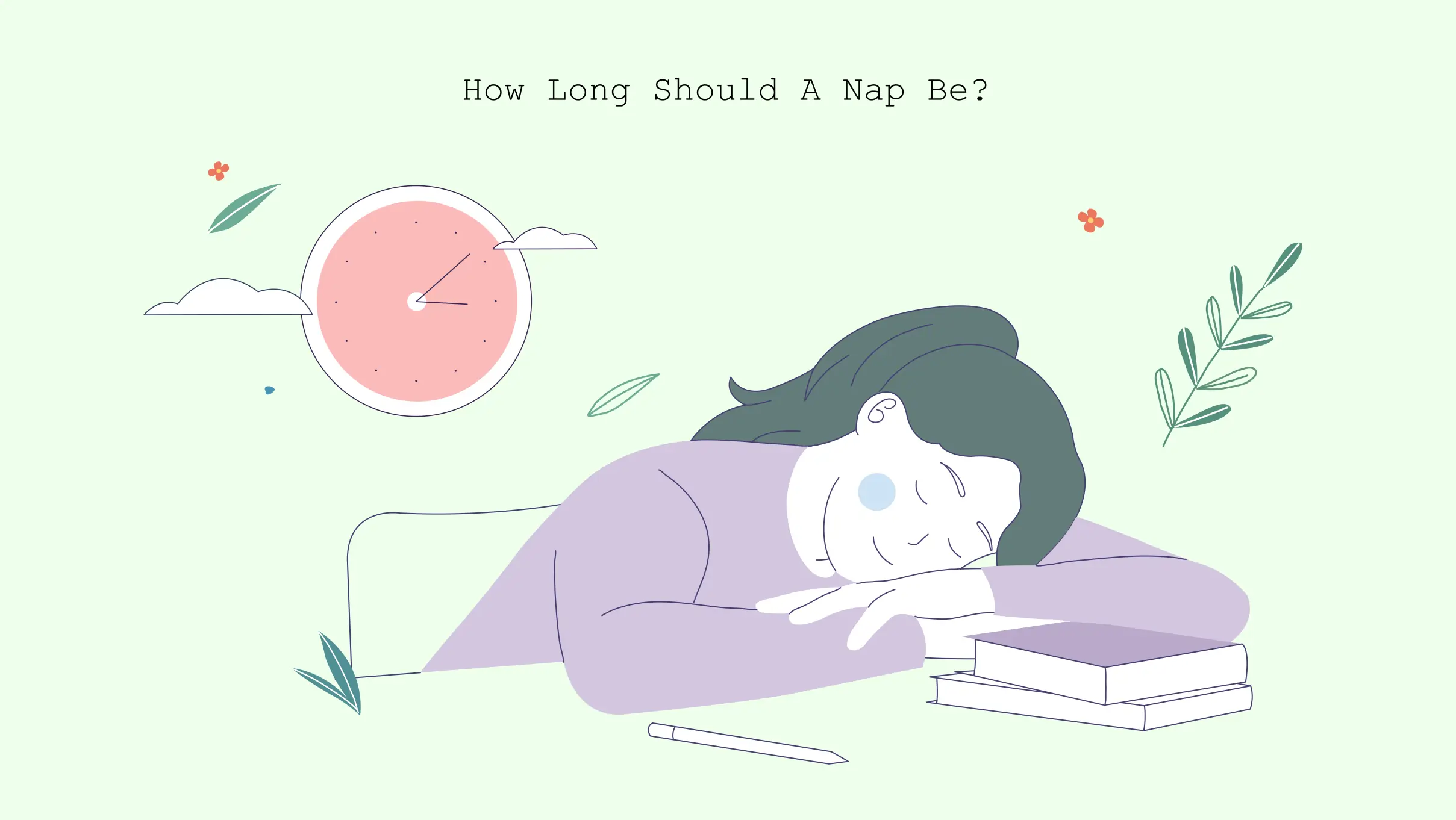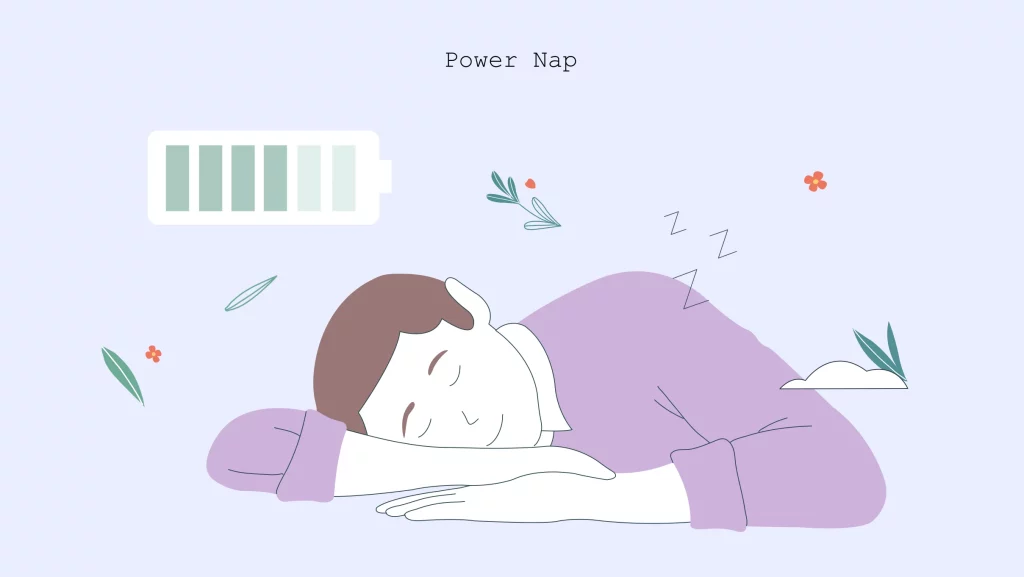Best Nap Length – How Long Should a Nap Be?
Written by


Imagine your air conditioner at full blast, and you are wrapped up like a burrito in a blanket. All this in the middle of the afternoon! Sounds fantastic, doesn’t it? Naps have always been a midday special. In fact, according to research, a midday siesta can be good for you. They are known to lower blood pressure, and the effects are similar to taking a tablet for the same. But, when the naps become too long, it can disrupt your good night’s sleep. So, what’s the best nap length? Between 5 to 45 minutes! But there’s more to it. In this article, we will tell you all about it.
Different Types of Naps
There is no one-size-fits-all when it comes to naps. Therefore, you can choose from types of naps as per your requirements.
Power Nap
A power nap is like the CEO of naps, and it is the most popular one out there! The best length of time for power naps is usually 10 to 25 minutes long. This short rest helps you feel refreshed and enhances productivity. So, try this best power nap length to feel fresh.
Coffee Nap
A coffee nap means taking a short 20-minute nap after drinking a hot cuppa. It is because it takes about that long for the effects of caffeine to stimulate the brain. But that’s not all. Adenosine circulates through the body when you are tired, and caffeine stops adenosine from reaching your brain. Hence, making you less exhausted.
Mind Breaks
When we think of naps, we associate them with sleeping. But that’s not it. Napping rejuvenates your mind. So, these mental breaks are short naps where you enjoy shut-eye for just 5-10 minutes. They easily fit into your schedule, and you can take mind breaks at work too! This is also the best nap length for studying.
Long Naps
Long naps are great when you feel too tired. Since it includes slow wave sleep, it offers you a deep sleep and enhances cognitive behaviour once you are up. Long naps are about 45-60 minutes long. While it can help you remember all the facts, names, and even faces more clearly, there are chances that you will end up feeling groggy.
Full Sleep Cycle
When you nap for approximately 90 minutes, you experience a full sleep cycle. Sleeping for a full sleep cycle helps boost your creativity and memory. Unlike long naps, here, you don’t experience grogginess because you wake up at the end of the cycle. So, you wake up fresh and well-rested. If you are sleep deprived, this can be the best length for a nap.
Best Nap Length
Wondering what is the best nap length? You must limit your naps to less than 30 minutes. It not only refreshes you but also offers an array of benefits, such as reduced blood pressure, enhanced concentration, and improved mood. But sleeping for more than 30 minutes can leave you feeling sluggish, groggy, and lethargic. However, completing a full sleep cycle, i.e., 90 minutes, can be beneficial if you are sleep deprived.
So, if you are wondering how long I should nap, it shouldn’t be more than 30 minutes. A full sleep cycle is the best nap length for headaches.
Different Types of Nap Lengths
The below table will give you a quick overview of the types of naps and ideal nap lengths.
| Nap Type | Duration |
|---|---|
| Power Nap | 10 – 25 minutes |
| Coffee Nap | 20 minutes |
| Mind Break | 5-10 minutes |
| Long Nap | 45-60 minutes |
| Full Sleep Cycle Nap | 90 minutes |
Best Nap Length for Adults
A nap helps you reset your mind and body. It ensures your productivity remains top-notch. So, what’s the best length of time for a nap for adults? Well, a 20-minute nap can be excellent. It improves drowsiness, enhances performance levels, and improves attentiveness.
Best Nap Length for Kids
Naps can be crucial for a child’s development. Newborn babies sleep most of the day and night. They wake up only a couple of hours to eat as they are still developing and it takes a lot of energy. They enjoy 2-3 naps a day, and that’s good for them.
Toddlers and young children can benefit from shorter naps, not more than 60 minutes and even teenagers can opt for 30-60 minutes of sleep in the afternoon, which is the best nap length to feel refreshed for them.
Benefits of Napping
Should you nap? Is it good for you? Let’s look at some of the significant benefits of napping.
Can Help With Memory: Did you know? Napping can strengthen your memory. It helps you remember everything you have learned in the day and ensures you don’t forget anything important, such as motor skills, verbal recall, and more.
Keeps You Relaxed: Taking a nap helps combat the stress you may be experiencing and boosts your mood.
Improves Your Performance: Taking short naps helps improve your performance and ensures you are more consistent.
Keeps You More Alert: Sometimes, it is a struggle post lunch to keep yourself alert. Here, a short nap can do wonders and keeps you more attentive.
Good For The Heart: According to a study, people who napped at least 1-2 times a week were 48% less likely to develop cardiovascular problems. But napping every day is not good for you.
Helps With Anxiety: Taking a nap in the afternoon between 1 to 3 P.M. for anywhere between 10-30 minutes can help reduce anxiety and enhance productivity.
Boosts Immune System: A short 30-minute nap can reverse any hormonal imbalance and mend neuroendocrine and immune health biomarkers to the right levels.
Drawbacks of Napping
Now that you know all the benefits of napping, let’s look at some drawbacks.
Sleep Inertia: It is possible that you may end up feeling sluggish or groggy after the nap.
Unable To Sleep At Night: If you take short naps during the day, it usually doesn’t affect your sleep at night. But, long sleep cycles at noon can affect your sleep at night and even disrupt your sleep schedule.
Type-2 Diabetes: Research has found that long naps are associated with type-2 diabetes. Sleeping for more than an hour during the daytime can increase the risk of type-2 diabetes by 45%.
How to Nap Effectively?
A few easy tips will help you nap better and ensure you make the most of your time. Take a look at some of the tips to nap effectively.
- Take Short Naps: Don’t plan to nap for more than 20 minutes. Anything beyond 30 minutes can make you groggy. Also, don’t sleep after 3 PM as it can interfere with your sleep at night.
- Keep A Restful Environment: Even when taking an afternoon nap, choose an optimal environment, such as a dark and cool room.
- Always Set An alarm: Afternoon naps are no less than a guilty pleasure. So, there are chances that without an alarm, you may end up oversleeping.
- Try To Nap On A Couch or Chair: Sleeping on your comfy bed may lead to sleeping more than you intend to.
- Try Coffee Nap: As mentioned earlier, you can always try a coffee nap where you consume coffee before napping.
Napping vs Sleeping – What Are the Differences?
The major difference between a nap and sleep is that a nap is a 20-30 minute sleep, whereas sleep is longer than 6 hours. Let’s take a look at all the other differences.
| Naps | Sleep |
|---|---|
| Sleep is when your body goes into a resting stage. Here, the body is inactive and the mind is unconscious. | What is a nap? Nap is short sleep taken during the day. |
| You need at least 7 hours of sleep every night. | A 20–30-minute nap is sufficient. |
| You go through several sleep cycles in one night. | You don’t go through a full sleep cycle during the nap. |
| It includes both REM and non-REM sleep. | It involves only non-REM sleep. |
Naps can increase alertness
Naps have been found to boost alertness and cognitive performance. When we sleep, our brain undergoes a process called sleep-dependent memory consolidation, which helps solidify newly acquired information. Napping capitalizes on this process, allowing the brain to consolidate memories and enhance learning.
Furthermore, naps can combat the effects of sleep deprivation by reducing fatigue and restoring energy levels. Research suggests that even short power naps of 10 to 20 minutes can improve alertness and reaction times. Napping also rejuvenates the body, leading to increased productivity and improved mood. However, it is important to note that longer naps can disrupt nighttime sleep, so it’s best to limit them to the early afternoon and avoid excessive duration.
Naps may reduce stress
Naps have been found to be effective in reducing stress levels. When we sleep, our body undergoes physiological changes that promote relaxation and rejuvenation. Napping can help alleviate the effects of stress by providing a period of rest and restoration, allowing the body and mind to recover from the demands of daily life.
Research suggests that even short power naps can enhance cognitive function, improve mood, and decrease stress hormone levels. Napping can also improve attention, concentration, and productivity, leading to better overall mental well-being. By taking regular naps, individuals can actively manage stress, enhance their ability to cope with challenges, and promote a healthier and more balanced lifestyle.
Conclusion
Naps can be excellent when you feel stressed and sleepy. Just a few minutes of shut-eye can do wonders for you and help you feel rejuvenated.
FAQs
Are daily naps healthy?
No. Frequent naps are not healthy as they are associated with a 12% higher risk of developing high blood pressure.
Why do I feel tired after a nap?
If you feel tired or groggy after a nap, it can be because of sleep inertia, which occurs when your nap exceeds more than 30 minutes. Even if you were sleep deprived, the best nap length for all-nighters is within 30 minutes. It is also the best nap length for focus.
What is the best time of day to nap?
The best nap time during the day is between 1 PM to 3 PM. And the best nap length when sleep deprived is 30 minutes.
Are naps bad for your heart?
One of the facts about napping is that napping every day is not suitable for you as it can increase the risk of high blood pressure and even stroke. So, are naps good for you? As long as they are not frequent, naps are good for you.
people like this article
Written by




